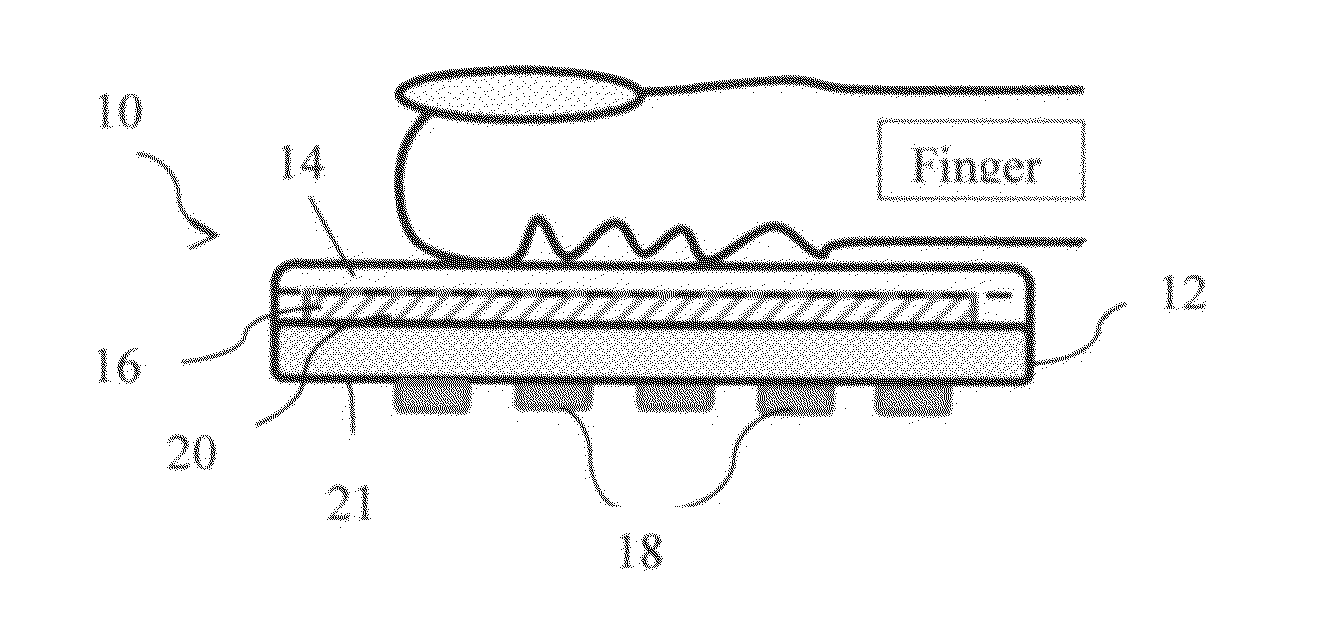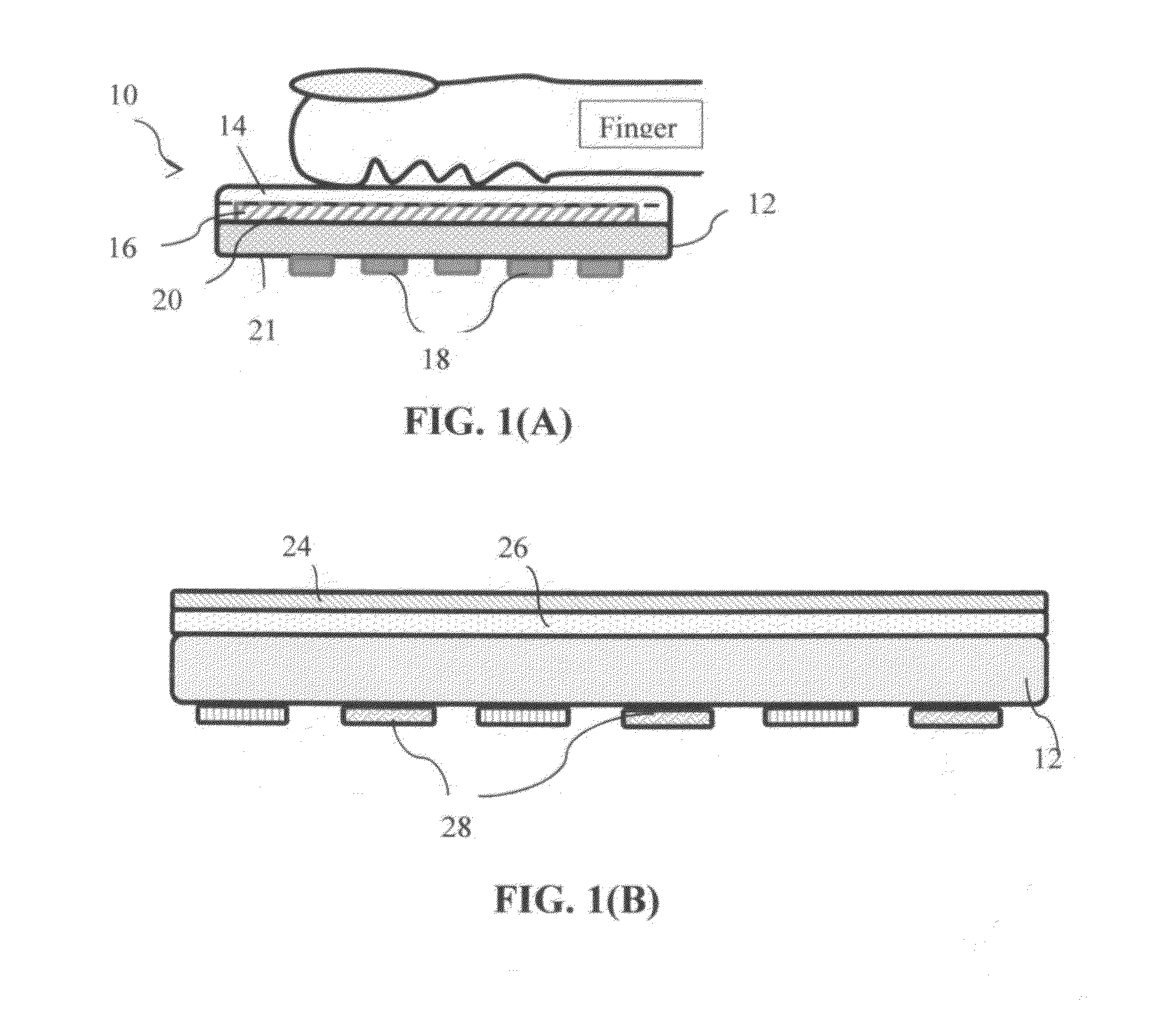Flexible fingerprint sensor materials and processes
- Summary
- Abstract
- Description
- Claims
- Application Information
AI Technical Summary
Benefits of technology
Problems solved by technology
Method used
Image
Examples
example 1
Layer (Domains) of a Conductive Material with No Coverage by a Protective Hard Coating
[0069]A typical procedure of producing a flexible laminate for a fingerprint sensor is described as follows: In one example, approximately 0.249 g of multi-layer graphene sheets (supplied by Angstron Materials, Inc., Dayton, Ohio, USA) was added to 2.25 g, 1.125% HPMC (Hydroxypropyl Methyl Cellulose) and then mixed with 0.35 g PES 20 (polyether sulfone) solution and 1.45 g, 1.5% silver nanowires (AgNW) to produce a conductive dispersion (suspension). The resulting suspension has a concentration of 5.8% graphene, 8.14% PES 20, 33.7% AgNW, 13% IPA, 38.7% H2O.
[0070]To prepare conductive films on polyimide (PI) substrates, we treated substrates with UV / Ozone or corona to make a low surface energy surface for improved wetting by the suspension when coated thereon and for improved adhesion between the substrate and graphene-AgNW conductive layer. The conductive dispersion was deposited onto the PI film b...
example 2
Layer of a Conductive Material with a Protective Hard Coating
[0073]In this series of examples, a thin layer of resin or resin-filler composite was applied as a protective hard coating. In this series, the suspension of graphene (or MWCNT, other fibrous conductive fillers) and the suspension of metal nanowires (AgNW or CuNW) or carbon nanotube / fiber (CNT or CNF) were prepared separately. For instance, 3.03 g graphene was dispersed in 30.07 g PET resin (Hank RZ 570) to produce a suspension having a graphene concentration of 9.15% by weight mixed with 90.85% PET resin. This is herein referred to as Suspension A. A suspension of AgNW or CuNW in a liquid mixture of methanol and water (Methanol: H2O=1:1) was prepared to produce a nanowire concentration of 0.065% by weight. This is referred to as Suspension B. Two mixing / coating routes were then followed: (a) Suspension A and Suspension B are mixed first, followed by coating onto a solid substrate surface; (b) Suspension A and Suspension B...
example 3
Spray-Coated Conductive Layers Covered by a UV-Cured Protective Coating
[0077]In one of this series of samples, graphene dispersion (Suspension A) was prepared by dispersing 3.03 g of graphene (Angstron N006) in 30.07 g PET resin (Hank RZ 570), which was diluted with 15.8 g IPA and 31.6 g H2O to produce a suspension with a graphene concentration of 3.76%, and PET resin of 37.3%. Suspension B was made in a way similar to that in Example 2 to produce a suspension containing a 0.065% concentration of AgNW in liquid medium (Methanol: H2O=1:1). Suspension C was obtained by mixing 0.2 g epoxy resin (K-500) with 3.31 g acrylic resin (R44-234) in 8.83 g of a co-solvent, forming a 1.62% concentration of UV-curable hard coat resin.
[0078]To prepare conductive graphene films on solid substrates, the substrate was treated with UV / Ozone to make low surface energy surface for graphene spray-coating layer. In one example, graphene dispersion (Suspension A) was spray-coated on the PI film. Then, AgNW...
PUM
 Login to View More
Login to View More Abstract
Description
Claims
Application Information
 Login to View More
Login to View More - R&D
- Intellectual Property
- Life Sciences
- Materials
- Tech Scout
- Unparalleled Data Quality
- Higher Quality Content
- 60% Fewer Hallucinations
Browse by: Latest US Patents, China's latest patents, Technical Efficacy Thesaurus, Application Domain, Technology Topic, Popular Technical Reports.
© 2025 PatSnap. All rights reserved.Legal|Privacy policy|Modern Slavery Act Transparency Statement|Sitemap|About US| Contact US: help@patsnap.com


